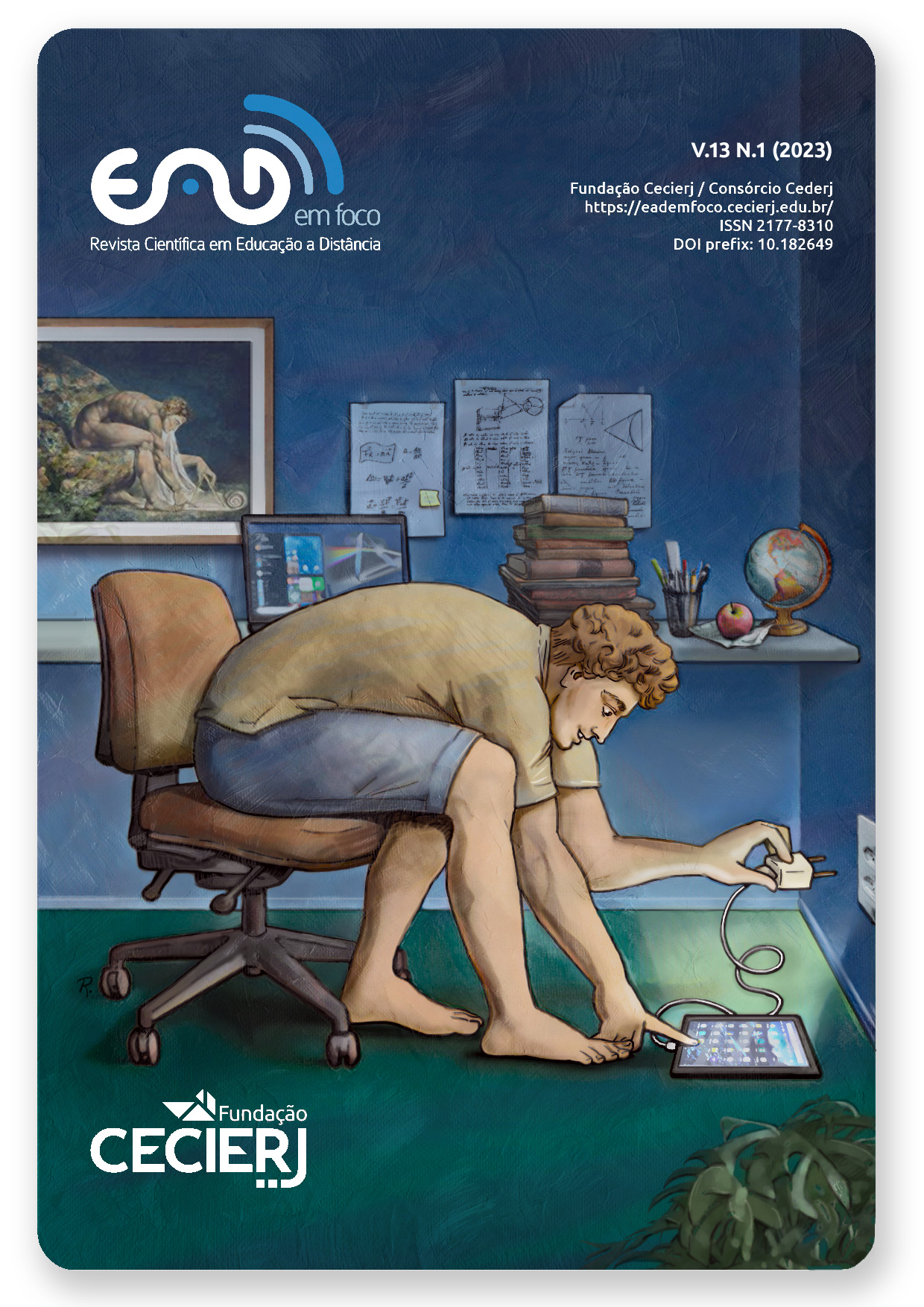Pedagogical Architecture for New Digital Learning Objects aimed at Affective Computing
DOI:
https://doi.org/10.18264/eadf.v13i1.1736Keywords:
Feeling of belonging, Cyberspace, Cognitive ergonomicsAbstract
This research intends to discuss a pedagogical issue that has been rapidly gaining prominence in the recent years, mostly due to an emerging phenomenon caused by coronavirus pandemics: the urgent demand for a Learning Management System (LMS) capable of potentializing students’ belonging feeling. Methodological foundation for this research was divided into three approaches, assuring data triangulation: bibliographic, qualitative, and exploratory-retroductive, that is, to answer a hypothesis for applicability purposes. How it would be possible to promote affective relations by means of a virtual learning environment? Taking this hypothesis into account, the evidence demonstrated that a few aspects should be considered in the design of a Digital Learning Object (DLO) for students to experience affective relations and feelings of belonging. Such criteria include the quality of internet access, the LMS’s pedagogical architecture, and the neurocognitive experience offered by the DLO. Therefore, the objective of this research was to ideate a DLO, having as a motto the pain of students from a Higher Education Institution (HEI). The aim was to propose a situationally thought DLO to potentialize the use of the LMS itself, and to instigate the feeling of belonging to a (virtual) place between teacher and student, i.e., to potentialize affective relations even in a cyberspace environment. Lastly, a DLO prototype was presented, namely ‘Conecta Mais’ (translated as ‘Connects More’), with the aim of stimulating co-participatory learning between students, teachers, and the community. This OAD is under development, in its pilot application phase at a Higher Education Institution in the State of Parana, in Brazil.
Keywords: DLO. Feeling of belonging. Cognitive ergonomics. Cyberspace. ICT.
Downloads
References
ASHTON, K. Making sense of the Internet of Things. Aruba/Hewllet Packard Company, 2017.
BAMIDIS, P. Affective learning: principles, technologies, practice. In: Frasson C., Kostopoulos G. (eds) Brain Function Assessment in Learning. BFAL 2017. Lecture notes in computer science, vol 10512. Springer, Cham. https://doi.org/10.1007/978-3-319-67615-9_1
BASSANI, P. S.; BEHAR, P. A. Análise das interações em ambientes virtuais de aprendizagem: uma possibilidade para avaliação da aprendizagem em EAD. RENOTE-Revista Novas Tecnologias na Educação, v. 4, n. 1, 2006.
BEHAR, P. A.; SILVA, K. K. A. Mapeamento de competências: um foco no aluno da educação a distância. RENOTE-Revista Novas Tecnologias na Educação, v. 10, n. 3, 2012.
BEHAR, P. A.; PASSERINO, L.; BERNARDI, M. Modelos pedagógicos para educação a distância: pressupostos teóricos para a construção de objetos de aprendizagem. RENOTE-Revista Novas Tecnologias na Educação, v. 5, n. 2, 2007.
CAÑAS, J. J.; WAERNS, Y. Ergonomia cognitiva: aspectos psicológicos de la interacción de las personas con la tecnologia de la información. Editora: Medica Panamericana, 2001.
CATH, C.; FLORIDI, L. The Design of the Internet's Architecture by the Internet Engineering Task Force (IETF) and Human Rights. Science and engineering ethics, v. 23, n. 2, p. 449-468, 2016.
DAMÁSIO, A. E o cérebro criou o homem. São Paulo: Companhia das Letras, 2011.
DELEUZE, G. Diferença e repetição. São Paulo: Paz & Terra, 2021.
FINK, D. Creating significant learning experiences: an integrated approach to designing college courses. San Francisco: Jossey-Bass, 2003.
FLORIDI, L. The fourth revolution: how the infosphere is reshaping human reality. UK: Oxford University Press, 2014.
FLORIDI, L. The ethics of information. UK: Oxford University Press, 2013.
GAVA, G. L. Viagem no tempo mental: uma abordagem filosófica sobre o cérebro global. Curitiba: CRV, 2019.
GAVA, G. L. EaD, Cérebro Global e Engenharia Reversa do Conhecimento: modelo hipotético de plataforma horizontal e o processo de aprendizagem a partir das TIC. EaD Em Foco, v. 6, n. 3, 2016. Disponível em: https://doi.org/10.18264/eadf.v6i3.406 - Acesso em: 27/07/2022.
GIL, A. C. Métodos e técnicas de pesquisa social. 6. ed. São Paulo: Atlas, 2008.
JAQUES, P. A.; NUNES, M. A. S. N. Computação Afetiva aplicada à Educação. Informática na Educação: games, inteligência artificial, realidade virtual/aumentada e computação ubíqua. Porto Alegre: Sociedade Brasileira de Computação, 2021. (Série Informática na Educação CEIE-SBC, v.7). Disponível em: https://ieducacao.ceie-br.org/computacaoafetiva - Acesso em 18/06/2022.
KUHN, T. A estrutura das revoluções científicas. 9ª ed. São Paulo: Perspectiva, 2009.
LÉVY, P. O que é o virtual? São Paulo: Editora 34, 2007a.
LÉVY, P. A inteligência coletiva: por uma antropologia do ciberespaco. 5. ed. São Paulo: Loyola, 2007b.
LONGHI, M. Teresinha et al. Um estudo sobre os fenômenos afetivos e cognitivos em interfaces para softwares educativos. RENOTE-Revista Novas Tecnologias na Educação, v. 5, n. 1, 2007.
LONGHI, M. T.; BERCHT, M.; BEHAR, P. A. Reconhecimento de estados afetivos do aluno em ambientes virtuais de aprendizagem. RENOTE-Revista Novas Tecnologias na Educação, v. 5, n. 2, 2007.
MARCO, J. P.; ARBELOA, F. J. S.; BAGDASARI, E. C.. Combining cognition and emotion in virtual agents, Kybernetes, vol. 46 No. 06, pp. 933-946. https://doi.org/10.1108/K-11-2016-0340 2017.
MITRA, S.; DANGWAL, R. Limits to self-organising systems of learning: the kalikuppam experiment. British Journal of Educational Technology, 41, 672–688. https://doi.org/10.1111/j.1467-8535.2010.01077.x. 2010.
MOROZOV, E.; BRIA, F. A cidade inteligente: tecnologias urbanas e democracia. São Paulo: Ubu Editora, 2020.
PEIRCE, C. S. Semiótica. São Paulo: Perspectiva, 2012.
PICARD, R. W. Affective computing. Cambridge, MA: MIT Press, 1997.
PRENSKY, M. Digital game-based learning. New York: McGraw-Hill, 2001.
SEVERINO, A. J. Metodologia do trabalho científico. São Paulo: Cortez, 2014.
SKINNER, B. F. Sobre o behaviorismo. São Paulo: Cultrix, 2009.
TAVARES, D. R. et al. An ontological approach of the cognitive and affective product experience, Frontiers in Neuroergonomics. v. 2, 2021. Disponível em: https://www.frontiersin.org/articles/10.3389/fnrgo.2021.602881/full - Acesso em: 17/07/2021. doi: 10.3389/fnrgo.2021.602881
TYNG, C. M. et al. The Influences of emotion on learning and memory. Front. Psychol, v. 8, p. 1454, 2017. Disponível em: https://www.frontiersin.org/articles/10.3389/fpsyg.2017.01454/full - Acesso em: 15/07/2022. doi: 10.3389 / fpsyg.2017.01454
VEEN, W.; VRAKKING, B. Homo Zappiens: educando na era digital. Porto Alegre: Artmed, 2009.
VILLAROUCO, V. et al. Neuroergonomia, neuroarquitetura e ambiente construído – tendencia futura ou presente?. Ergodesign & HCI, [S.l.], v. 8, n. 2, p. 92-112, dec. 2020. ISSN 2317-8876. Disponível em: http://periodicos.puc-rio.br/index.php/revistaergodesign-hci/article/view/1459 - Acesso em: 12/072021. doi: http://dx.doi.org/10.22570/ergodesignhci.v8i2.1459.
Published
How to Cite
Issue
Section
License
Copyright (c) 2023 EaD em Foco

This work is licensed under a Creative Commons Attribution 4.0 International License.
All articles published in Revista EaD em Foco receive the license
Creative Commons - Atribuição 4.0 Internacional (CC BY 4.0).
All subsequent publications, complete or partial, must be made with the acknowledgment, in citations, of the Revista EaD em Foco as the original editor of the article.













